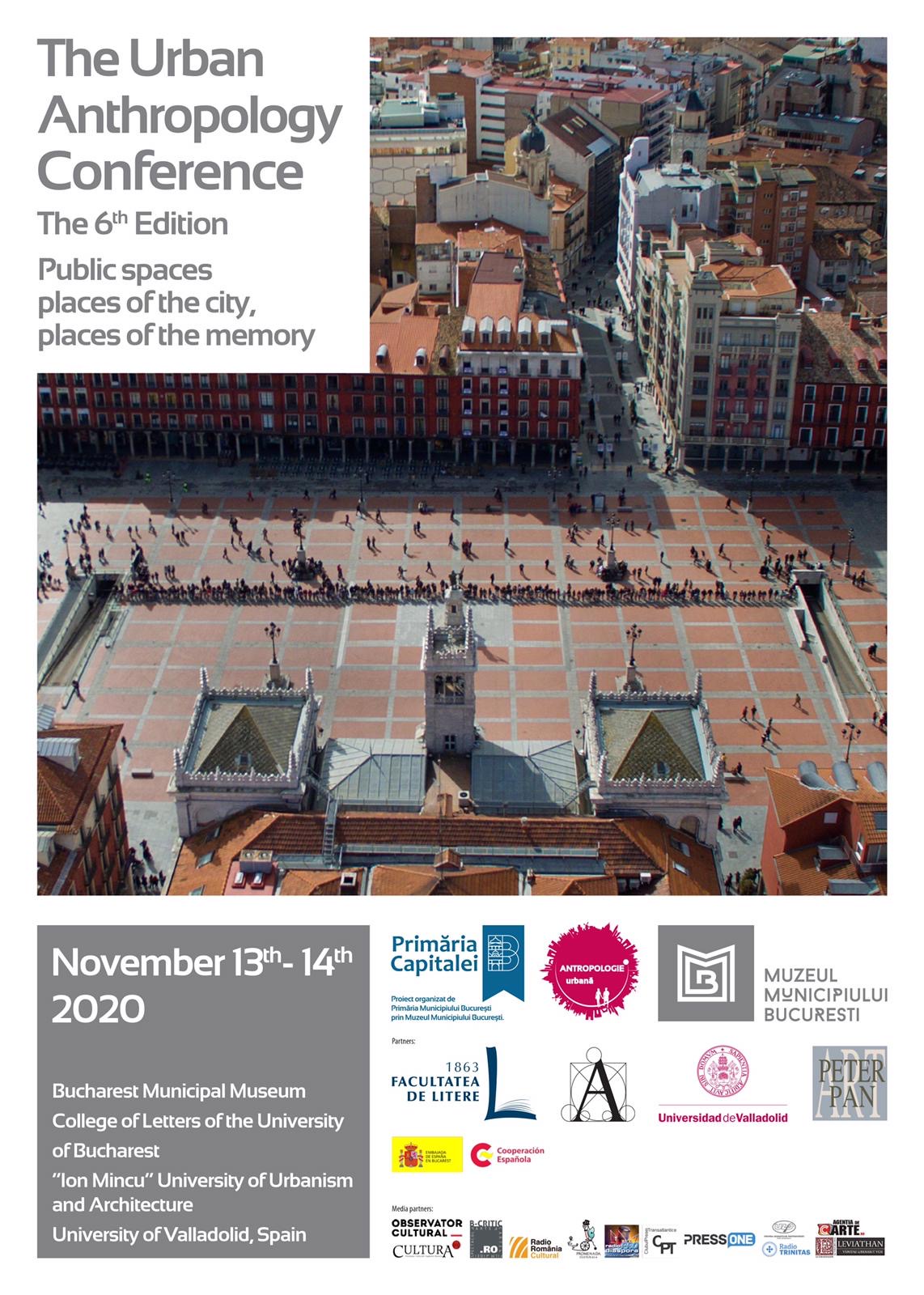The Bucharest Municipality Museum, The College of Letters of the University of Bucharest, the “Ion Mincu” University of Urbanism and Architecture of Bucharest, Romania, and the University of Valladolid, Spain, are proud to announce the 6th edition of the International Conference of Urban Anthropology, with the theme Public spaces: places of the city, places of memory, in Bucharest, November 13th – 14th 2020. A city can be read just as one reads a book. The ‘letters’ of this book are buildings, street plans, marks left on constructions over time, by the way people walk around the city, and by how vehicles move about in urban spaces.
Cities are a mixture of people and buildings, and the relationship between community and the constructed space is more complicated than it may appear at first glance. People make buildings, and, over time, these constructions and the spaces in-between form cities. Once built, cities gain identity. They decisively influence the way of being, acting, and thinking of people who inhabit them. The relationship between a community and its space features multiple nuances, stratified, and sometimes not apparent at first.
The 6th Edition of the Conference of Urban Anthropology focuses on an anthropological reading of the relationships between the public spaces of cities, the people who traverse them and the communities that created them. In The City Assembled, Spiro Kostoff shows that, although public space is a rather unclear concept, and that, even though it is often difficult to trace a clear line between public and private, two aspects of urban life support the pertinence of the idea of public space. We cross the city to meet friends or acquaintances, S. Kostof states, at a park bench, in the square, or in front of the cathedral. But everyone, he adds, can choose when and how they arrive, thus exposing themselves to unpredictable situations: one can meet anyone, and encounter the gestures of strangers. Public space is, first of all, a stage for daily life, for the familiar and the unusual in equal manner. The freedom to act or to remain inactive is intrinsically linked to the nature of public spaces as territories of day-to-day life.
On the other hand, public spaces are stages for rituals. They host a wide variety of community activities – from concerts and festivals to religious ceremonies, historical or political celebrations or, in older times, public executions. This is why public spaces carry the marks of the city’s memory. The way these spaces are conceived, structured, embellished with monuments, capable of glorifying moments or characters belonging to the place’s history, underlines this ritualistic character of public spaces.
A reality with fluctuating geometry, the public space is a witness of continuities and ruptures, of the history of architectural fashions, trends and archetypes, while also containing the volatile images of societies that created it or knew it during a particular sequence of time. As in Honoré de Balzac’s novels, foregoing the separation of territory descriptions from descriptions of the communities that shaped them, the memory of places is, in fact, the memory of those who, at one point, took on these spaces. And the landmarks of this memory are monumental, perceived as a link
between generations, an instrument to prompt the flux of memories and an artefact risen against the perishability of things. The columns, statues and arches of antiquity are nowadays replaced with other types of structures meant to make absence present, and to bring the fragments of yesterday into today.
Public space can give birth to a plethora of interpretations from the most varied fields, from history to architecture and urbanism, from sociology and urban anthropology to philosophy, politics, geocriticism and sciences of communication. The main theme of the conference will be split into four axes, organised in different sections:
- Squares, streets, parks, monuments. Spaces, places and public speeches;
- Daily life of public spaces;
- Public spaces and rituals;
- Writings on cities and cities in writings.
Memory, S. Freud wrote in Civilisation and Its Discontents, is structured like a city. The example he proposes is Rome, because Rome maintains the different layers of past developments. One century after Freud, we can reverse the terms of the comparison. A city is like memory, it conserves different layers of past developments and public spaces shine the spotlight, more or less discretely, on these superposed lives of the city.
DEADLINES
May 15th 2020 – Deadline for the abstracts (max 4.000 characters)
May 30th 2020 – Conclusion of abstract selection and communication to selected authors
September 15th 2020 – Deadline for final papers (max 30.000 characters)
Abstracts and papers will be in English, Spanish, French or Romanian.
Please, send the abstracts and the final papers to:
antropologie@muzeulbucurestiului.ro.
The presentations held will be published in the Urban Anthropology Magazine. Presentations will be in English, Spanish, French, and Romanian.
Coordinator of the conference: conf. univ. dr. Cătălin D. Constantin
The Organising Committee is composed of: Eliana Radu, Maria Sfrijan, Silvia Zamfir (The Bucharest Municipality Museum); prof. univ. dr. Augustin Ioan (The “Ion Mincu” University of Urbanism and Architecture); conf. univ. dr. Cristina Bogdan; conf. univ. dr. Alexandra Crăciun (The College of Letters of the University of Bucharest); prof. univ. dr. Mercedes Cano Herrera (University of Valladolid).
The Scientific Committee is composed of: dr. Adrian Majuru; dr. Dan Pîrvulescu; dr. Vasile Opriș (The Bucharest Municipality Museum); prof. univ. dr. Mercedes Cano Herrera (University of Valladolid); prof. univ. dr. Carmen Mușat; conf. univ. dr. Cristina Bogdan; conf. univ. dr. Cătălin D. Constantin (The College of Letters of the University of Bucharest); prof. univ. dr. Sorin Vasilescu (The “Ion Mincu” University of Urbanism and Architecture); prof. univ. dr. Doina Ruști; dr. Andreea Răsuceanu (external members).
The conference is free of charge.
